Neural Dual Solver#
This tutorial shows how to use OTT to compute the Wasserstein-2 optimal transport map between continuous measures in Euclidean space that are accessible via sampling.
W2NeuralDual solves this
problem by optimizing parameterized Kantorovich dual potential functions
and returning a DualPotentials
object that can be used to transport unseen source data samples to its target distribution (or vice-versa) or compute the corresponding distance between new source and target distribution.
The dual potentials can be specified as non-convex neural networks PotentialMLP or an input-convex neural network ICNN [Amos et al., 2017]. W2NeuralDual implements the method developed by [Makkuva et al., 2020] along with the improvements and fine-tuning of the conjugate computation from [Amos, 2023]. For more insights on the approach itself, we refer the user to the original sources.
import sys
if "google.colab" in sys.modules:
%pip install -q git+https://github.com/ott-jax/ott@main
import jax
import jax.numpy as jnp
import numpy as np
from torch.utils.data import DataLoader, IterableDataset
import optax
import matplotlib.pyplot as plt
from IPython.display import clear_output, display
from ott import datasets
from ott.geometry import pointcloud
from ott.neural.methods import neuraldual
from ott.neural.networks import potentials
from ott.tools import sinkhorn_divergence
Setup training and validation datasets#
We apply the W2NeuralDual to compute the transport between toy datasets.
Here, we aim at computing the map between two toy datasets representing both, source and target distribution using the
datasets simple (data clustered in one center) and circle (two-dimensional Gaussians arranged on a circle) from create_gaussian_mixture_samplers.
In order to solve the neural dual, we need to define our dataloaders. The only requirement is that the corresponding source and target train and validation datasets are iterators that provide samples of batches from the source and target measures. The following command loads them with OTT’s pre-packaged loader for synthetic data.
num_samples_visualize = 400
(
train_dataloaders,
valid_dataloaders,
input_dim,
) = datasets.create_gaussian_mixture_samplers(
name_source="simple",
name_target="circle",
valid_batch_size=num_samples_visualize,
)
def plot_samples(eval_data_source, eval_data_target):
fig, axs = plt.subplots(
1, 2, figsize=(8, 4), gridspec_kw={"wspace": 0, "hspace": 0}
)
axs[0].scatter(
eval_data_source[:, 0],
eval_data_source[:, 1],
color="#A7BED3",
s=10,
alpha=0.5,
)
axs[0].set_title("Source measure samples")
axs[1].scatter(
eval_data_target[:, 0],
eval_data_target[:, 1],
color="#1A254B",
s=10,
alpha=0.5,
)
axs[1].set_title("Target measure samples")
for ax in axs:
ax.set_xticks([])
ax.set_yticks([])
ax.set_xlim(-6, 6)
ax.set_ylim(-6, 6)
return fig, ax
# Sample a batch for evaluation and plot it
eval_data_source = next(valid_dataloaders.source_iter)
eval_data_target = next(valid_dataloaders.target_iter)
_ = plot_samples(eval_data_source, eval_data_target)
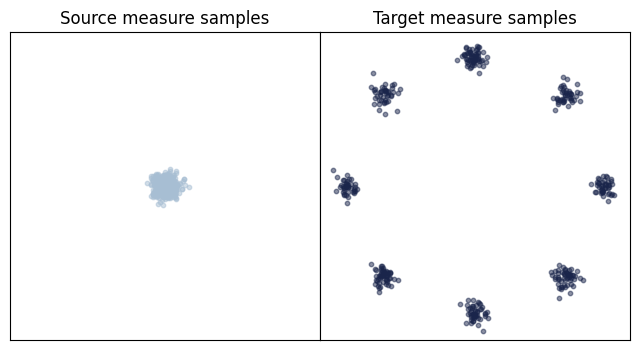
Next, we define the architectures parameterizing the dual potentials \(f\) and \(g\). We first parameterize \(f\) with an ICNN and \(\nabla g\) as a non-convex PotentialMLP. You can adapt the size of the ICNNs by passing a sequence containing hidden layer sizes. While ICNNs are by default containing partially positive weights, we can run the W2NeuralDual using approximations to this positivity constraint (via weight clipping and a weight penalization).
For this, set pos_weights to True in ICNN and W2NeuralDual.
For more details on how to customize ICNN,
we refer you to the documentation.
# initialize models and optimizers
num_train_iters = 5001
neural_f = icnn.ICNN(
dim_data=2,
dim_hidden=[64, 64, 64, 64],
pos_weights=True,
gaussian_map_samples=(
eval_data_source,
eval_data_target,
), # initialize the ICNN with source and target samples
)
neural_g = potentials.PotentialMLP(
dim_hidden=[64, 64, 64, 64],
is_potential=False, # returns the gradient of the potential.
)
lr_schedule = optax.cosine_decay_schedule(
init_value=1e-3, decay_steps=num_train_iters, alpha=1e-2
)
optimizer_f = optax.adam(learning_rate=lr_schedule, b1=0.5, b2=0.5)
optimizer_g = optax.adam(learning_rate=lr_schedule, b1=0.9, b2=0.999)
Train Neural Dual#
We then initialize the W2NeuralDual by passing two ICNN models parameterizing \(f\) and \(g\), as well as by specifying the input dimensions of the data and the number of training iterations to execute. Once the W2NeuralDual is initialized, we can obtain the neural DualPotentials by passing the corresponding dataloaders to it.
Execution of the following cell will probably take a few minutes, depending on your system and the number of training iterations.
def training_callback(step, learned_potentials):
# Callback function as the training progresses to visualize the couplings.
if step % 1000 == 0:
clear_output()
print(f"Training iteration: {step}/{num_train_iters}")
fig, ax = learned_potentials.plot_ot_map(
eval_data_source,
eval_data_target,
forward=True,
)
display(fig)
plt.close(fig)
fig, ax = learned_potentials.plot_ot_map(
eval_data_source,
eval_data_target,
forward=False,
)
display(fig)
plt.close(fig)
fig, ax = learned_potentials.plot_potential()
display(fig)
plt.close(fig)
neural_dual_solver = neuraldual.W2NeuralDual(
input_dim,
neural_f,
neural_g,
optimizer_f,
optimizer_g,
num_train_iters=num_train_iters,
pos_weights=True,
)
learned_potentials = neural_dual_solver(
*train_dataloaders,
*valid_dataloaders,
callback=training_callback,
)
clear_output()
The output of the solver, learned_potentials, is an instance of DualPotentials. This gives us access to the learned potentials and provides functions to compute and plot the forward and inverse OT maps between the measures.
learned_potentials.plot_potential(forward=True)
learned_potentials.plot_potential(forward=False)
(<Figure size 600x600 with 2 Axes>, <Axes: title={'center': '$g$'}>)
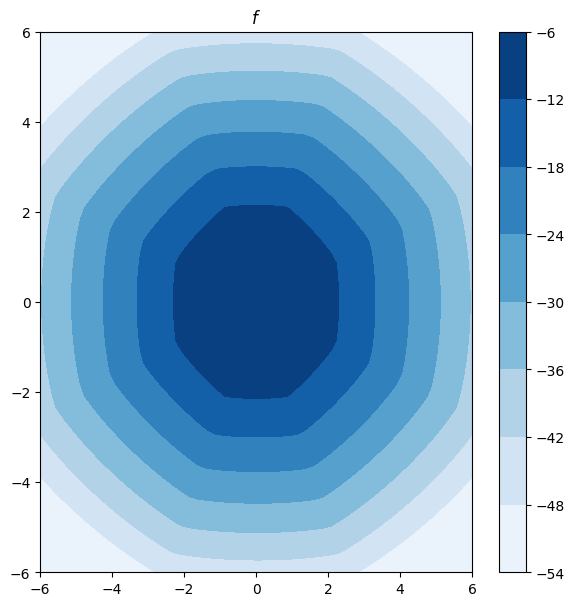
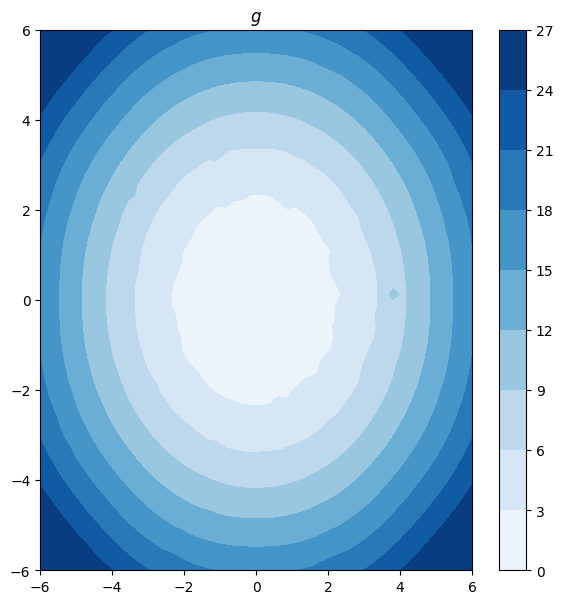
Evaluate Neural Dual#
After training has completed successfully, we can evaluate the neural DualPotentials on unseen incoming data. We first sample a new batch from the source and target distribution.
Now, we can plot the corresponding transport from source to target using the gradient of the learning potential \(g\), i.e., \(\nabla g(\text{source})\), or from target to source via the gradient of the learning potential \(f\), i.e., \(\nabla f(\text{target})\).
learned_potentials.plot_ot_map(
eval_data_source,
eval_data_target,
forward=True,
)
(<Figure size 640x480 with 1 Axes>, <Axes: >)
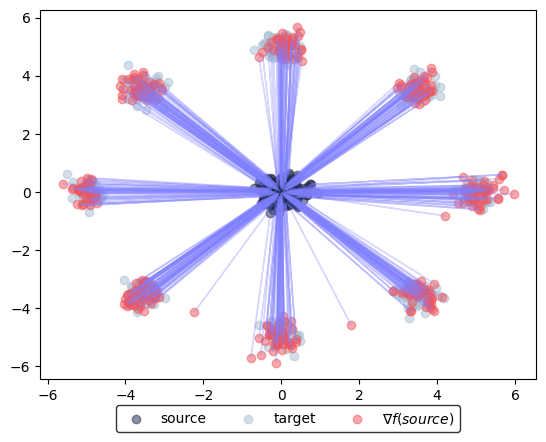
learned_potentials.plot_ot_map(
eval_data_source, eval_data_target, forward=False
)
(<Figure size 640x480 with 1 Axes>, <Axes: >)
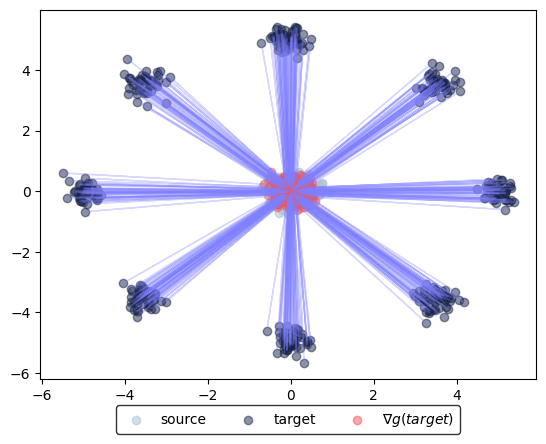
We further test, how close the predicted samples are to the sampled data.
First for potential \(g\), transporting source to target samples. Ideally the resulting Sinkhorn distance is close to \(0\).
@jax.jit
def sinkhorn_loss(
x: jnp.ndarray, y: jnp.ndarray, epsilon: float = 0.1
) -> float:
"""Computes transport between (x, a) and (y, b) via Sinkhorn algorithm."""
a = jnp.ones(len(x)) / len(x)
b = jnp.ones(len(y)) / len(y)
sdiv = sinkhorn_divergence.sinkhorn_divergence(
pointcloud.PointCloud, x, y, epsilon=epsilon, a=a, b=b
)
return sdiv.divergence
pred_target = learned_potentials.transport(eval_data_source)
print(
f"Sinkhorn distance between target predictions and data samples: {sinkhorn_loss(pred_target, eval_data_target):.2f}"
)
Sinkhorn distance between target predictions and data samples: 0.86
Then for potential \(f\), transporting target to source samples. Again, the resulting Sinkhorn distance needs to be close to \(0\).
pred_source = learned_potentials.transport(eval_data_target, forward=False)
print(
f"Sinkhorn distance between source predictions and data samples: {sinkhorn_loss(pred_source, eval_data_source):.2f}"
)
Sinkhorn distance between source predictions and data samples: 0.00
Besides computing the transport and mapping source to target samples or vice versa, we can also compute the overall distance between new source and target samples.
neural_dual_dist = learned_potentials.distance(
eval_data_source, eval_data_target
)
print(
f"Neural dual distance between source and target data: {neural_dual_dist:.2f}"
)
Neural dual distance between source and target data: 21.95
Which compares to the primal Sinkhorn distance in the following.
sinkhorn_dist = sinkhorn_loss(eval_data_source, eval_data_target)
print(f"Sinkhorn distance between source and target data: {sinkhorn_dist:.2f}")
Sinkhorn distance between source and target data: 22.00
Solving a harder problem#
We next set up a harder OT problem to transport from a mixture of five Gaussians to a mixture of four Gaussians and solve it by using the non-convex PotentialMLP potentials to model \(f\) and \(g\).
(
train_dataloaders,
valid_dataloaders,
input_dim,
) = datasets.create_gaussian_mixture_samplers(
name_source="square_five",
name_target="square_four",
valid_batch_size=num_samples_visualize,
)
eval_data_source = next(valid_dataloaders.source_iter)
eval_data_target = next(valid_dataloaders.target_iter)
plot_samples(eval_data_source, eval_data_target)
(<Figure size 800x400 with 2 Axes>,
<Axes: title={'center': 'Target measure samples'}>)
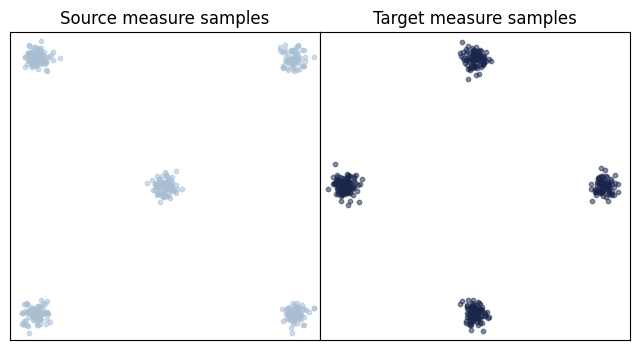
num_train_iters = 20001
neural_f = potentials.PotentialMLP(dim_hidden=[64, 64, 64, 64])
neural_g = potentials.PotentialMLP(dim_hidden=[64, 64, 64, 64])
lr_schedule = optax.cosine_decay_schedule(
init_value=5e-4, decay_steps=num_train_iters, alpha=1e-2
)
optimizer_f = optax.adamw(learning_rate=lr_schedule)
optimizer_g = optimizer_f
neural_dual_solver = neuraldual.W2NeuralDual(
input_dim,
neural_f,
neural_g,
optimizer_f,
optimizer_g,
num_train_iters=num_train_iters,
)
learned_potentials = neural_dual_solver(
*train_dataloaders,
*valid_dataloaders,
callback=training_callback,
)
clear_output()
We can run the same visualizations and Wasserstein-2 distance estimations as before:
learned_potentials.plot_ot_map(eval_data_source, eval_data_target, forward=True)
learned_potentials.plot_ot_map(
eval_data_source, eval_data_target, forward=False
)
pred_target = learned_potentials.transport(eval_data_source)
print(
f"Sinkhorn distance between target predictions and data samples: {sinkhorn_loss(pred_target, eval_data_target):.2f}"
)
pred_source = learned_potentials.transport(eval_data_target, forward=False)
print(
f"Sinkhorn distance between source predictions and data samples: {sinkhorn_loss(pred_source, eval_data_source):.2f}"
)
neural_dual_dist = learned_potentials.distance(
eval_data_source, eval_data_target
)
print(
f"Neural dual distance between source and target data: {neural_dual_dist:.2f}"
)
sinkhorn_dist = sinkhorn_loss(eval_data_source, eval_data_target)
print(f"Sinkhorn distance between source and target data: {sinkhorn_dist:.2f}")
Sinkhorn distance between target predictions and data samples: 1.60
Sinkhorn distance between source predictions and data samples: 1.30
Neural dual distance between source and target data: 20.73
Sinkhorn distance between source and target data: 21.20
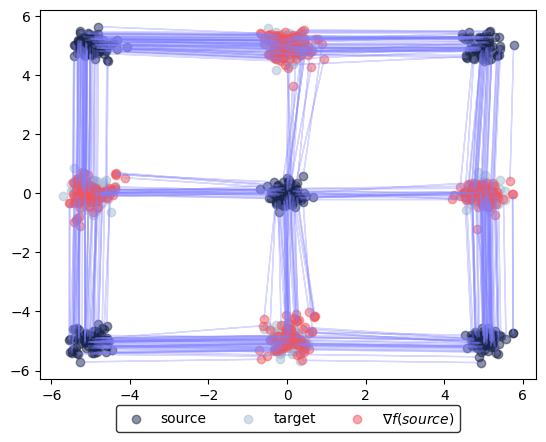
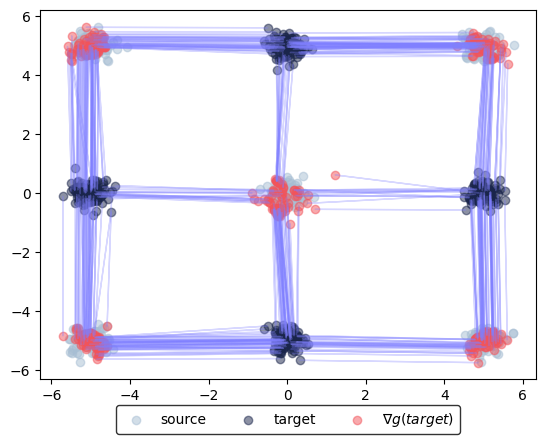
The next portion computes the optimal transport maps between other synthetic 2D datasets from scikit-learn. For simplicity, we run only for 5001 iterations.
def solve_and_plot(
source_name, target_name, ax, num_train_iters=5001, batch_size=4096
):
try:
from w2ot import data
except ImportError:
print(
"Please install the w2ot package from "
"https://github.com/facebookresearch/w2ot "
"for the scikit-learn dataloaders"
)
raise
pair_data = data.Pair2d(
mu=source_name, nu=target_name, batch_size=batch_size
)
source_sampler, target_sampler = pair_data.load_samplers()
def sampler_iter(sampler):
key = jax.random.PRNGKey(0)
while True:
k1, key = jax.random.split(key, 2)
yield sampler.sample(key=k1, batch_size=batch_size)
source_sampler = sampler_iter(source_sampler)
target_sampler = sampler_iter(target_sampler)
train_dataloaders = (source_sampler, target_sampler)
valid_dataloaders = train_dataloaders
input_dim = 2
neural_f = potentials.PotentialMLP(dim_hidden=[64, 64, 64, 64])
neural_g = potentials.PotentialMLP(dim_hidden=[64, 64, 64, 64])
lr_schedule = optax.cosine_decay_schedule(
init_value=5e-4, decay_steps=num_train_iters, alpha=1e-2
)
optimizer_f = optax.adamw(learning_rate=lr_schedule)
optimizer_g = optimizer_f
neural_dual_solver = neuraldual.W2NeuralDual(
input_dim,
neural_f,
neural_g,
optimizer_f,
optimizer_g,
num_train_iters=num_train_iters,
)
learned_potentials = neural_dual_solver(
*train_dataloaders,
*valid_dataloaders,
)
eval_data_source = next(source_sampler)[:num_samples_visualize]
eval_data_target = next(target_sampler)[:num_samples_visualize]
learned_potentials.plot_ot_map(
eval_data_source, eval_data_target, forward=False, ax=ax
)
ax.get_legend().remove()
ax.axis("equal")
ax.get_xaxis().set_visible(False)
ax.get_yaxis().set_visible(False)
ax.set_facecolor("white")
plt.setp(ax.spines.values(), color="k")
display(ax.get_figure())
nrow, ncol = 1, 4
fig, axs = plt.subplots(nrow, ncol, figsize=(4 * ncol, 4 * nrow))
solve_and_plot("sk_circle_big", "sk_circle_small", axs[0])
fig.legend(
ncol=3, loc="upper center", bbox_to_anchor=(0.5, -0.01), edgecolor="k"
)
solve_and_plot("sk_moon_lower", "sk_moon_upper", axs[1])
solve_and_plot("sk_s_curve", "gauss_1_unit", axs[2])
solve_and_plot("sk_swiss", "gauss_1_unit", axs[3])
fig.subplots_adjust(wspace=0, hspace=0)
clear_output()



